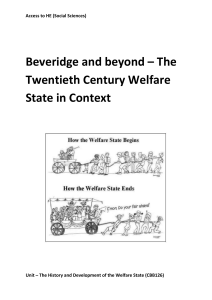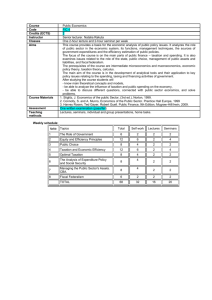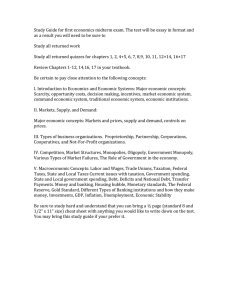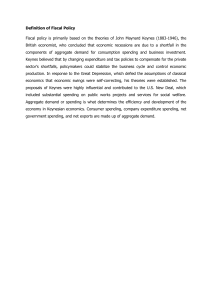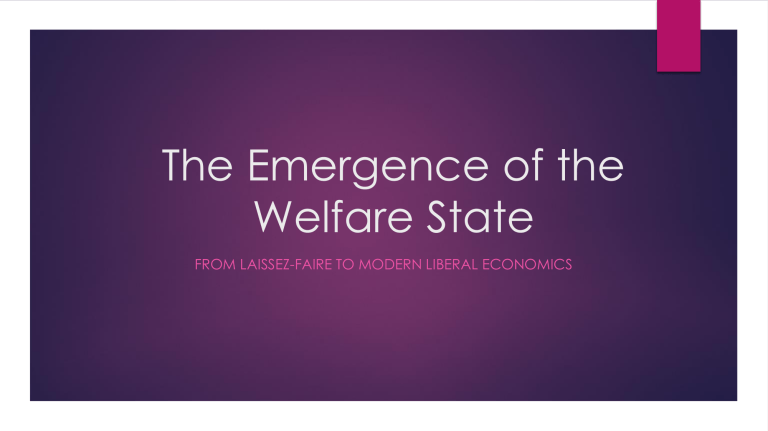
The Emergence of the Welfare State FROM LAISSEZ-FAIRE TO MODERN LIBERAL ECONOMICS Modern Liberalism Welfare States A welfare state is a government that looked out for the welfare of its citizens. This meant providing economic support through food programs, financial assistance, subsidized housing, and many other publicly owned and funded programs and industries. This is definitely not classical liberalism – where is the freedom (from government intervention)? Welfare states are based on limited application of the principles of collectivism - ideas of moderate government intervention to look out for citizens, particularly vulnerable citizens during hard times. It starts with capitalism but embraces some of the collectivist principles that allow people to maintain at least a minimum standard of living. Mixed Economy As governments began to intervene in the economy to provide this support - through taxation, publicly-owned property, and wealth redistribution - many economies could no longer claim to be purely capitalist. Many economies were now mixed economies; still largely capitalist but featuring moderate, modern liberal government intervention and control in various parts of the economy. Welfare State These states are based on the modern liberal application of principles of collectivism in balance with principles of individualism – thus becoming moderate (middle): Equality of outcome - cooperation and collective interest Equitable (fair)distribution of wealth economic equality and public property Public responsibility for the less fortunate - collective responsibility The state provides freedom from worry about the bare necessities for its citizens by providing a social safety net – something that can catch them if they fall between the cracks. The Social Safety Net Some examples of this safety net in action are: Cash transfers - programs like Employment Insurance in Canada whereby the unemployed can draw on emergency funds, paid for by taxpayers (working people) for a limited time, to afford the necessities when they’re in between jobs. Food programs - programs like food banks, food stamp / coupon programs, or subsidies for families that have a hard time affording food. Public healthcare and education – programs that provide taxpayer funded, (nearly-) universal health insurance and public education, are key to our Canadian identity. Few of us can say we don’t sometimes need a safety net … Progressive Taxation How do they afford these programs??? Through higher taxes! Progressive taxation is common in welfare states. This is a policy whereby higher wage earners pay more taxes (a higher % of their income) than do lower wage earners. The more government intervention present, the stronger the welfare state, and the further left on the spectrum the state is (don’t forget – governments change – so there are shifts left and right depending on the policies of the government in power!) More centrist welfare states feature mixed economies, while very interventionist, left- leaning (but still democratic) welfare states are known as democratic socialism (Bernie Sanders represents this position on the spectrum with his 95% taxation rate proposed for all billionaires!) So how did we get here? To the Delorian! SET IT TO THE ROARING TWENTIES! The Roaring Twenties – “Unfettered Capitalism” Ever watch the “Party Scene” from Great Gatsby? Now THAT’S excess wealth! Freedom at its finest! The United States was the richest country in the world (resources & population). After the war, the U.S.A. became wealthy by mass producing consumer goods like radios and cars (no longer needed to support the war effort!) The USA also became the breadbasket for Europe during WWI – a major exporter of grain products. Factory workers were paid well, which meant they were now able to spend money on all those consumer goods. But this was only the beginning … of the end … As the ‘20s progressed, more and more working people were buying shares (pieces of ownership in) of companies “on margin” or “on time” (credit) and these shares rose in value or price. Factories were producing more goods than people could buy; therefore, the supply of goods was much greater than the demand. According to capitalism, that must mean prices will drop … After the war ended, America continued to produce large amounts of grain. When France began producing grain again, the market became flooded and the price of grain plummeted (supply & demand at work again!). People began selling off their stocks to try to recoup their losses. The Stock Market Crash of 1929 In 1929 share prices were rising but profits for companies began to decline. By September and October, the market was fluctuating wildly On October 24th of 1929, panic selling of shares forced the value of shares to drop drastically. By October 29th, the market crashed. The stock market crash brought an end to prosperity in the U.S.A. Wall Street Crash Video “Run on the Bank” Everyone wants to withdraw their money, but the bank can’t cover all these requests at once. The result: • Massive loss of savings • Loss of consumer confidence Other Causes of The Great Depression Demand for goods could not keep up with supply Droughts Wages did not increase to match inflation Farmers went bankrupt Banks failed Factories closed Increase in unemployment High rate of corporate fraud • GDP – Gross Domestic Product dropped by 35% (a measure of the wealth of a nation on a per person, per year basis) - shows how much economy shrunk • Unemployment reached 32%!! (what is it in Alberta right now?) • Men unable to provide for their families – there are no jobs to be found! • WHY? • unregulated business - people pursued their SELF-INTEREST to make profits • unregulated banking - LAISSEZ-FAIRE – (privately-owned) banks were lending more money that they had assets to cover (9:1 ratio). They were trying to make money, not protect consumers! • Overwhelming consumer confidence: business was booming so people shopped to practice their economic freedom; they borrowed (then owed) and invested large sums of money. Conditions were much the same in Canada. Angry farmers dubbed horse-drawn automobiles the “Bennett Buggy” after Prime Minister Richard (R.B) Bennett. By 1931, unemployed people were lining up in breadlines since there was no unemployment insurance. Countries used protective tariffs in an attempt to protect domestic industry, so global trade declined. By 1932, 12 million people in the US were unemployed. President Herbert Hoover feared that assistance from the government would make citizens reliant and unable to stand on their own two feet. In 1932, the American people voted for Franklin D. Roosevelt as president on a platform of government intervention to get the USA out of the Depression. How do you stop the cycle? Who is/should be to blame? Who will/should help? Role of Government – security and stability? Crisis can lead to extreme responses (e.g. Communism or Fascism) Hyperinflation in Germany 1919-1923 (at end of WW1) Hyperinflation: inflation that is very high or "out of control“; a condition in which prices increase rapidly as a currency loses its value. Example of bad government intervention –poor monetary policy: unchecked increase in money supply (printed more paper money without a growing economy to back up its value!!) Between 1919 and 1923, the price of a loaf of bread increased from 26 pfennigs to 80 billion Mark!! • Authoritarian systems: provide simple solutions to complex problems Example Fascism & Communism both tried to provide what they felt people (and the economy) needed “People’s of government planning to create jobs and stimulate the German economy (1937) Car” One man had a solution: John Maynard Keynes He proposed a solution to this problem through the regulation of government spending, taxation, the regulation of the interest rates and production of money. In doing so, governments could regulate consumer demand, thus regulating the economy. BUT – this is a pretty big shift left from the market economy and capitalism! John Maynard Keynes: A British economist who developed the theory known as “Demand Side Economics” or “Keynesian Economics” in response to Great Depression Demand Side Economics Fiscal Policy FISCAL POLICY INVOLVES GOVERNMENT SPENDING - ON PUBLIC INDUSTRY, INFRASTRUCTURE, AND SOCIAL SAFETY NET PROGRAMS - AND TAXATION. DECREASED PUBLIC SPENDING AND HIGHER TAXATION DURING BOOM TIMES MEANS FEWER PUBLIC JOBS / SOCIAL PROGRAMS AND MORE INCOME TAKEN FROM CITIZENS BY THE STATE IN TAXES. THIS DECREASES AVAILABLE CASH FOR SPENDING AND INVESTMENT AND COOLS A STRONG ECONOMY TO PREVENT IT FROM OVERHEATING. KEYNES CALLED THIS “TIGHTENING THE BELT”. INCREASED PUBLIC SPENDING AND LOWER TAXATION DURING ‘BUST’ TIMES MEANS MORE PUBLIC JOBS / SOCIAL PROGRAMS AND LESS INCOME TAKEN FROM CITIZENS BY THE STATE IN TAXES. THIS INCREASES AVAILABLE CASH FOR SPENDING AND INVESTMENT AND STIMULATES A WEAK ECONOMY TO PREVENT IT FROM SINKING TOO DEEPLY INTO RECESSION. KEYNES CALLED THIS “PRIMING THE PUMP”. DEMAND SIDE ECONOMICS MONETARY POLICY Monetary policy is a little more complicated. It relies on government controlling interest rates. The higher the prime interest rate - which banks use to determine their own interest rates - the more expensive it is to borrow money, and the more worthwhile it is to invest that money. During boom times, increasing interest rates means borrowing money is more expensive. This means people are disincentivized to borrow, and therefore have less money to spend. High interest rates also encourage people to invest their money, as they will earn more on their investments. During bust times, decreasing interest rates means borrowing money is less expensive. This means people are incentivized to borrow, and therefore have more money to spend. Low interest rates also discourage people to invest their money, as they will earn less on their investments. Keynes wanted to “flatten the curve” (not that one!) - preferred the gentle slopes of the --- line instead of the peaks and valleys of the Boom/Bust cycle. So … let’s review … During Boom/Expansion, take money away… Monetary Policy: Increasing interest rates means borrowing money is more expensive. This means people are less likely to borrow, and therefore have less money to spend. Fiscal Policy: Decreased public spending and higher taxation means less public jobs / social programs and more income taken from citizens by the state in taxes. During Bust/Recession, Add more money… Monetary Policy: Decreasing interest rates means borrowing money is less expensive. This means people are incentivized to borrow, and therefore have more money to spend. Fiscal Policy: Increased public spending and lower taxation means more public jobs / social programs and less income taken from citizens by the state in taxes. This increases available cash for spending and stimulates a weak economy prosperity FISCAL POLICY Increase government $ FISCAL POLICY depression Decrease government $ Decrease taxes Increase taxes MONETARY POLICY MONETARY POLICY Increase $ supply Decrease $ supply Decrease interest rates Increase interest rates Deficit financing Pg. 146-147 Government spending Cycle (deficit financing) Government will go into debt (years of accumulated deficits), however will hopefully save money when times are good, so should balance out. Why might a govt not cut spending though when times are good? Roosevelt and the New Deal President Franklin D. Roosevelt (FDR) was one of the first to implement Keynesian economics to try to pull the US out of the Depression Roosevelt put forth an idea known as the New Deal, and he implemented policies that changed the way the American government interacted with its people forever: Relief: Direct financial help to those in need Recovery: Policies intended to fix the economy and create jobs to put people back to work Reform: Programs designed to regulate the economy to prevent conditions in the future that could create another Depression New Deal explained in 3 minutes Rise of the Welfare State The New Deal certainly didn’t end the Depression, but it definitely helped. By the time World War II broke out, unemployment in the US had dropped by 10%. The Second World War, in its own way, proved Keynesian principles to be effective as well. Governments used deficit financing through the sale of patriotic war bonds to put millions to work building guns, tanks, and bombs to battle the Nazis. By the time the War was over, the Great Depression was too - and Keynes and his supporters argued that if we could win the war, why couldn’t we “Win the Peace”? Democracies all across the western world agreed, and many implemented comprehensive welfare states over the next several decades. Rise of the Welfare State - Canada Almost 2 years after Roosevelt implement the New Deal in the US, Canadian Conservative PM R.B. Bennett announced a similar program in Canada. Seen as “too little, too late”, he was defeated in the 1935 election and replaced by Liberal PM W.L. MacKenzie King. Although some programs and changes were implemented, many were struck down under judicial as ‘unconstitutional’ and outside federal jurisdiction. It wasn’t until after WW2 that Keynes’ ideas were widely embraced in Canada: Established near universal public health insurance Developed an unemployment insurance program Created a national old age pensions for senior Canadians to draw on in their twilight years Established progressive taxation to pay for these various social programs Created many public industries like the CBC (1936) Founded the Bank of Canada (1934) to regulate interest rates and currency in Canada By the 70s, Canada was a truly modern liberal state, with elements of collectivism embedded within our still largely capitalist system. Review Video
